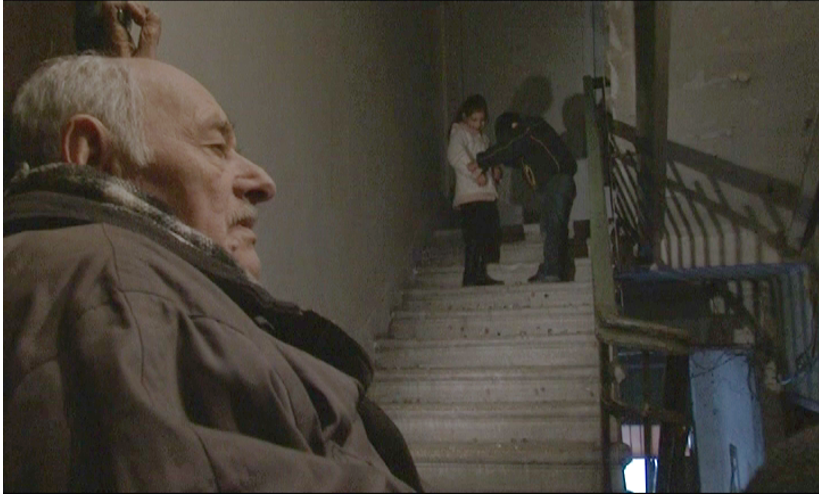In modern auteur cinema there are several specific signs that even young directors apply and often they do it not because a film needs it but because a specific standard has been created and this standard must be taken into account “by all means.” Thus, it is a frequent imitation in films. On the one hand, imitation is a process of learning and development, however, it becomes a hindering factor for a director, especially a novice one. This is the problem. The means, whatever it is and what kind it is, needs to be used wisely. The author may not give a specific purpose to any detail and leave it to the audience to decide, which is a familiar practice, but if he loads the main elements of the film with witless functions, then the director will at the very least have a very difficult time keeping his point.
Sandro Suladze's student film "Tuta" (2016) is an interesting work with its attempts and parallels but the flaws that this film has are also interesting.
The main character of the film is Tuta (Mariam Enukidze), a young girl whose mother dies and is left alone with her father (Bidzina Macharashvili), who is addicted to wine. A difficult life test begins for her.
Tuta and her father live in the mountains. The environment chosen by the director echoes the girl’s inner state. By showing the landscapes, the general appearance of the mountain is drawn. It is big, cold, but attractive, distant, unrecognizable and, most importantly, alien. Actress Mariam Enukidze, with her interesting appearance, physically corresponds exactly to Tuta's image, whose appearance is a kind of embodiment of the described landscape. As the camera digs deeper into the environment, focusing on specific corners and paths from the sprawling fields and mountains, it becomes clear that this beautiful nature is not as pure on the inside as it appears at a glance. It is gray, remote, muddy, windy. This internal description of nature perfectly matches the state of Tuta’s heart. Sometimes the rays of the sun entering the shots can be considered as hope, the hope of dispelling the cold and nestling the warmth.
Tuta tries to escape the painful reality in any way. She finds a solution in reading books. She moves from gray reality to illusion on paper, but she is still here. A memorable moment is when she pours water on the blood mixed in the mud to neutralize the blood and make it disappear. During these 25 minutes, there are a couple of phrases that the main character says: “It is turquoise. My mother presented it to me. She left me." She utters this phrase in response to nothing, but the viewer can feel how much loss this girl has, and the other phrase: "Have you drunk?" is a question that does not have a verbal answer and does not need one, because Tuta’s pain is obvious.
Sandro Suladze's directorial solution includes keeping a distance, which has become a very popular method. The camera is more like an observer. He simply describes and does not reveal its attitude, does not enter into dialogues with the characters. Such a position is interesting and attractive, but very risky. The difficulty lies in the fact that the director must convey the character's inner weight and moral or psychological pressure in such a way that one does not empathize with the character. At such a time, the cinematographer needs special skills to manage to connect the audience and the hero at a distance. In addition, in such cases, the responsibility of the actor increases and requires greater skill to tell the story in silence and minimal action.
The camera position and viewing angles are wrong in some episodes. The logical chain of storytelling is also broken, which is significantly manifested during the change of shots. For example, the actors’ placement, the position of the body does not match from one episode to another. In some cases, this is specifically done in films but in this one, there are no signs of it. As well as the special use of camera, but in “Tuta,” the static, which the shots do not have, grossly breaks the unified structure of the film. Fortunately, this is an easily fixable problem. Especially since Nikoloz Kereselidze, the cameraman of the film, is trying to select interesting shots.
The acting side, unfortunately, is one of the weakest links in Georgian cinema, student or professional. This time, too, the actors’ acting is quite unconvincing, although this is mostly expressed in the verbal part.
The biggest disadvantage of "Tuta" is the sound effects. External noises and soft bubbling come in rudely and become a disturbing factor. It is especially noticeable how the sound stops during the change of shots and how the background sounds continue with a different frequency during a new shot. It would be better to overdub the sounds of the environment. Sound is one of the main discomforts when watching a movie.
Sandro Suladze's film "Tuta” really arouses interest in the director. His work is an attempt to create modern auteur cinema, and an acceptable attempt. The director seems to have combined the episodes from the films he was interested in and tried to convey them. For example, the scene in which Tuta and the father sit face to face and eat an egg seems to me to be a replay of an episode of Bela Tarr’s movie "The Turin Horse,” not only in the position of the bodies and the action, but also in the aura, bringing the silence to the fore. Similar solutions make films more diverse and complete.
Each disadvantage of the film crew is based entirely on experience. In practice, all the mentioned flaws will be corrected over time. The director himself in this film really shows the skills necessary for the profession, which requires intensive training.
Gvantsa Nozadze






